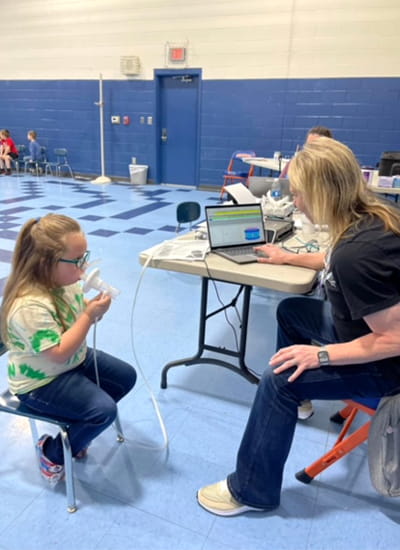Program Identifies Asthma in Kids Before an Emergency
It is a simple question: “Does your child wheeze going up the stairs?”
For children and families in Knoxville, Tennessee, asthma is rarely talked about.
That’s why East Tennessee Children’s Hospital is turning school hallways into a frontline defense against one of the most common chronic diseases among kids.
“This program is for children and families who are not aware of asthma symptoms so we can proactively identify asthma and get kids early treatment,” said Becky Miller, community benefit manager.

The Breathe Easy initiative brings regular asthma screenings into schools across the hospital’s 19-county service area, especially in rural communities with limited access to health care. Respiratory therapists and pulmonologists come equipped with a symptom questionnaire, pulmonary function test, and asthma education.
And the need is significant in the area. Tennessee ranks among the top 20 states for childhood asthma, with 6.1% of kids living with the disease. If untreated, it can cause emergency department visits, hospitalizations, and missed school days.
“Having the right tools in place has helped to reduce exacerbations,” Miller said. “The screenings have allowed us to identify children who are potentially undiagnosed and kids who are untreated or have poorly controlled asthma.”
During the 2024-2025 school year, the hospital program screened 531 elementary schoolers; 55 had an abnormal screening.
When tests are abnormal, asthma educators make follow-up calls to families within three months of the initial screening, and the results are shared with the child’s primary care physician.
Kids are sent home with the results and information so families can identify asthma symptoms, know how to react when they occur, and have the knowledge needed to engage in better conversations with their doctor.
“Some of these families don’t think about asthma when their kids have a cough,” Miller said. “Parents have been grateful that this program has diagnosed their children and provided medication to manage it.”
The hospital works with school nurses and coordinators to schedule the screenings and send students home with forms for parents to complete. On the day of the screening, kids are only out of the classroom for about two minutes to breathe into a little tube and receive asthma education.
Breathe Easy also collaborates with school nurses to educate and build awareness of asthma symptoms and provide additional support, such as helping with 504 plans so diagnosed children have equal access to education.
Looking ahead, Miller hopes to expand the program to reach more school districts and more children because prevention is power.
In response to the Make America Healthy Again (MAHA) Commission’s report on child health, the Children’s Hospital Association is highlighting ways children’s hospitals are helping children live longer and healthier lives by confronting the root causes of chronic illnesses.
Contact Us
About Children's Hospital Association
Children’s Hospital Association is the national voice of more than 200 children’s hospitals, advancing child health through innovation in the quality, cost, and delivery of care.